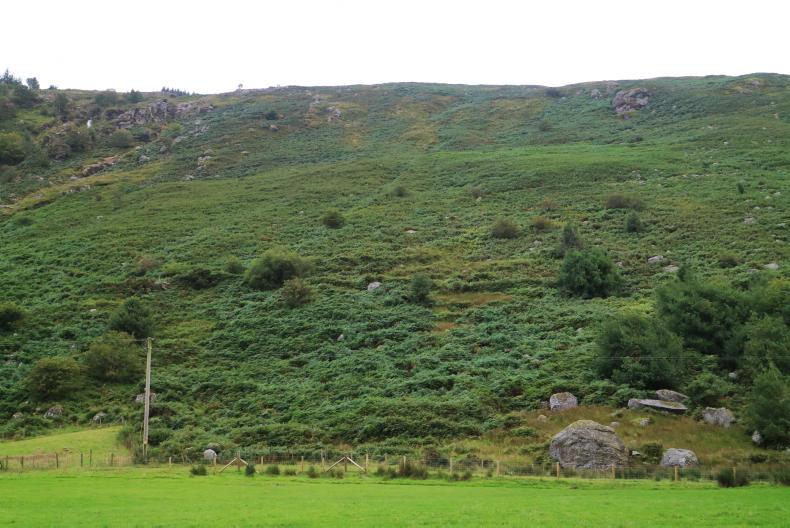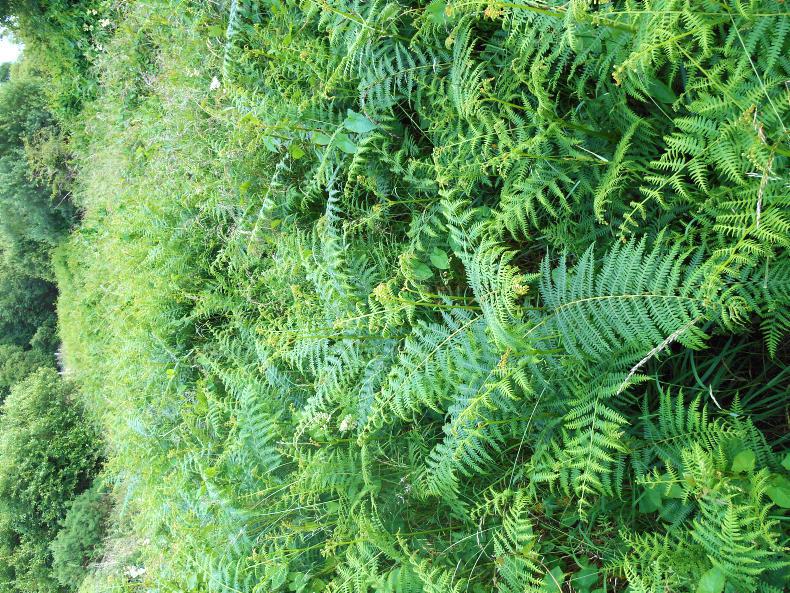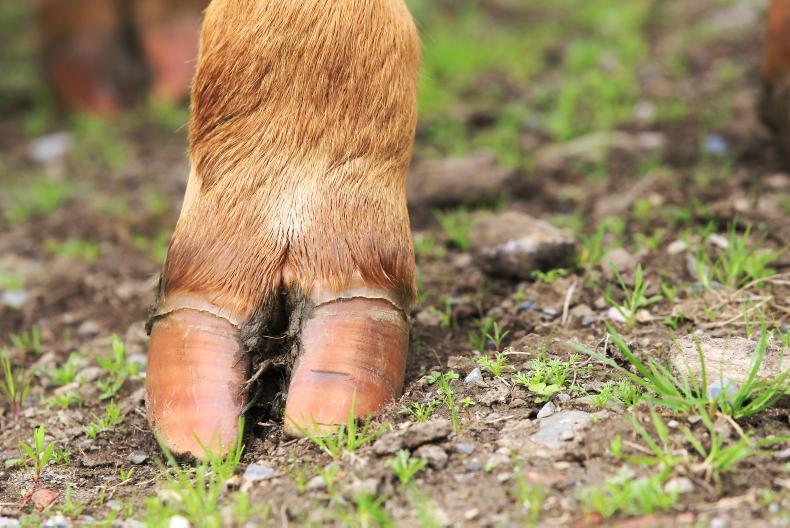Bracken is a member of the fern family. It is known for its vigorous growth and it spreads quickly across land through its long underground stems called rhizomes.
Bracken grows best on good drainage sites, usually on mountain slopes or upland. As part of the Basic Payment Scheme, farmers have to maintain land in such a way that it is suitable for grazing or cultivation. The Guide to Land Eligibility on the Department of Agriculture’s website outlines what is acceptable when it comes to bracken/ferns and what isn’t. In the document, the Department says that bracken emerges annually in early summer and starts to die off when the first frosts arrive in autumn.
Where bracken has grass underneath, it will result in the land being in a grazable state, which means the area is eligible for scheme payments.
The Department says, however, that bracken with no grass underneath will not be grazable by animals and is therefore not eligible and the area must be deducted in full.
Pictures one and two
In picture one, we see sheep grazing grass underneath bracken. According to the Department, this is acceptable. In picture two, however, where there is no grass present and the bracken has completely taken over. This area is not acceptable.
There are many reasons why farmers should try to control bracken, where possible. For one, it improves the productivity of the land farmed.
Controlling bracken allows grasses to grow which provides grazing for stock, reducing pressure on heather and unimproved grassland elsewhere.
Where it is controlled, it makes herding of stock far easier and improves accessibility to land. Bracken is poisonous to livestock if they are forced to eat it. It is an excellent tick habitat and it harbours the early life stages of sheep ticks, which can transmit diseases such as louping ill to sheep, as well as Lyme disease to humans.
Cutting the growing bracken with a topper/mulcher can help, but only in places where it is accessible with a tractor and topper.
This is a long-term approach, because there will be surviving rhizomes that will grow back again.
Bracken should be cut twice a year during the summer when it is actively growing. It may take three successive years of this approach to eradicate the majority of the infestation. This method cannot be used if there is a risk to ground nesting birds or if the angle of the slope is large, as there will be a high risk of erosion after bracken removal.
Trampling by livestock during the year may also help to expose the rhizomes to frost damage.
You have to be careful with over-grazing livestock, however, because in the spring there is a danger that stock may graze young bracken and get poisoned or they may graze out heather, allowing the spread of bracken even more.
Rolling/crushing may help in areas where it is not suitable to use a topper. It is not as effective as cutting but it helps to reduce the food source by damaging the upper part of the fern before it can pass nutrients down to its rhizomes.
In a lot of cases, bracken grows on steep hill land (usually rocky areas) that is not suitable for mechanical cutting. Spraying offers another effective option for controlling bracken. Asulam (sold as Asulox) and glyphosate (eg Roundup) both effectively kill bracken, but Asulox is preferable because it is selective compared with glyphosate, which kills everything.
Asulox is specifically used for bracken control and was banned over a number of years, leaving no effective control for the treatment of bracken. This year, however, United Phosphorous Limited as manufacturers of Asulox, and Croplink (Ireland) Limited, as their Irish distributors were granted “emergency clearance” to import Asulox under strict conditions.
Emergency use authorisation is granted from 1 June to 30 September 2015. Emergency clearance was granted consecutively for the last three summers, allowing farmers to buy and spray their bracken with Asulox.
Picture three
Bracken should be sprayed when it is in full frond (all fronds fully expanded), but before yellowing (start of senescence). See picture three. Normally, this will be within the period from mid-July to late August.
For tractor-mounted sprayers, the boom height should be adjusted to give uniform coverage at the top of the bracken fronds.
Always follow manufacturers’ guidelines in terms of rates of application.
After controlling bracken physically or chemically, it should be followed up with lime application, where possible, to improve the pH of the soil.
Bracken prefers acidic soils, but it can also grow on high pH soils. Raising the pH level will help to increase grass growth, which will compete better with the bracken.
Pictures four and five
In pictures four and five, we can see the visible difference between an area that was controlled and an area that wasn’t.
It shows that it is possible to improve similar land to increase productivity.
Pat Dunne (pictured), chair of the IFA Hill Farming Committee, feels that the lifting of the ban on Asulox will only partly help in the control of bracken.
He says that there are areas where bracken is actively growing and is not suitable for tractor-mounted sprayers or even knapsack work due to difficult terrain. He would like to see the Department of Agriculture grant derogations for aerial spraying of bracken – similar to some derogations approved in the UK. However, this might not be a simple process for those involved.
















SHARING OPTIONS